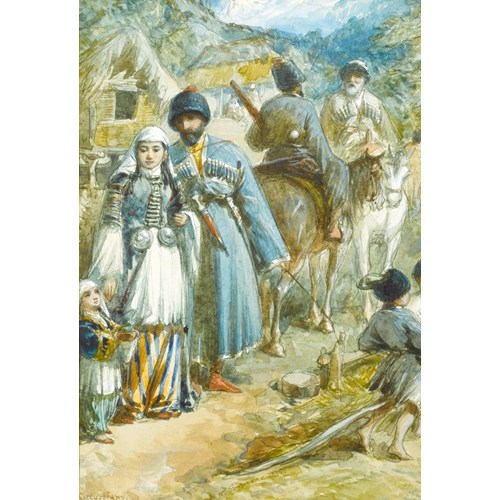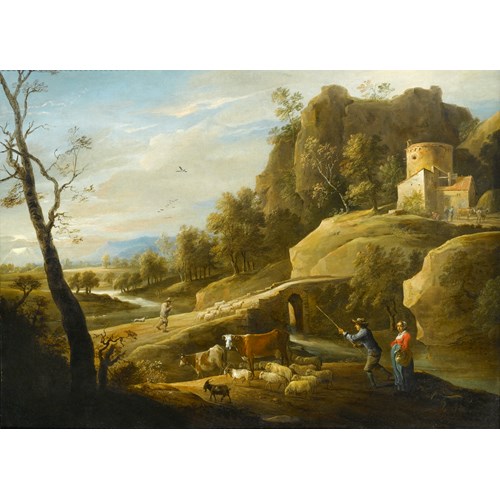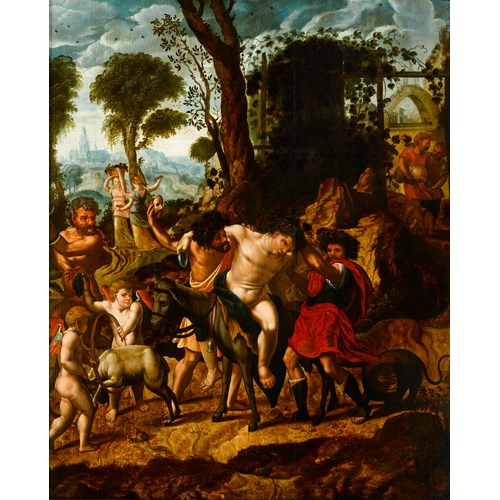Marketplace
Imperial Convoy
Konstantin Nikolaevich Filippov
Imperial Convoy
Period 1850-1900, 19th century
Origin Russia
Medium Watercolour on paper
Dimension 23 x 47.5 cm (9 x 18³/₄ inches)
A vast steppe stretches out towards mountains veiled in cloud. A military convoy has settled on the dry land and set up white tents between scattered rocks. The horses are still loaded with equipment and gathered at the centre of the camp. A soldier in a long beige coat and black fleece hat stands guard with his sword positioned diagonally across his chest. Another soldier slowly passes by with a black horse and further to the right, two others converse by the tents.
Konstantin Nikolaevich Filippov was sent to the Russian army in an official capacity, to depict scenes from the Crimean War (1853-1856). It was a particularly horrific war, defined by a catalogue of logistical and tactical failures between the Russian Empire and an alliance of the British Empire, France, the Ottoman Empire and the Kingdom of Sardinia. The war developed out of various conflicts between the great powers in the Middle East, and more directly from the Russian demand to carry out protection over the Orthodox subjects of the Ottoman Sultan. Another key factor was the disagreement between France and Russia about the privileges of the Russian Orthodox and Roman Catholic churches in the holy places in Palestine. For the Russians this war was known as the ‘Oriental War’, and was fought mainly on the Crimean Peninsula. It is possible that Filippov depicted the military convoy on the Peninsula, as the landscape in the northern and central area is similar to that depicted in Imperial Convoy.
The Crimean War has been called the ‘first modern war’, for it was characterised by significant developments in various fields, including rapid communication of news and images. Progress in transportation, electric telegraphy and printing, enabled reporters to send news reports to their home countries faster, and to print news rapidly and in large quantities. The immediacy with which news reached people was unprecedented; it was the same with images, for this was the first war to be documented by photographers. The British print dealer, Dominic Colnaghi, sent an artist to the war-zone instead of a photographer. With new printing techniques the artist’s watercolours could be reproduced rapidly as tinted lithographs. At the time photographs needed an exposure of nearly twenty seconds, with the consequence that photographs mainly depicted posing soldiers. Watercolours on the other hand could capture the atmosphere, drama and misery of war. Filippov was evidently sent to document the Crimean War and his watercolour documents a moment of calm in a world of chaos and tragedy.
Filippov painted genre scenes and battle-pieces. In 1858, he graduated from the Imperial Academy of Fine Arts. He lived and painted in Warsaw, Rome and Paris and returned to Russia in 1863. The artist spent the remainder of his life in Southern Crimea. Filippov acquired the title of Academician for his large painting Flight of the Bulgarians from the Danube River with Retreat of Russian Army from Silistriya in 1865. Filippov’s paintings are exhibited in the renowned State Tretyakov Gallery, Moscow and the Pushkin Museum of Fine Arts, Moscow.
Konstantin Nikolaevich Filippov was sent to the Russian army in an official capacity, to depict scenes from the Crimean War (1853-1856). It was a particularly horrific war, defined by a catalogue of logistical and tactical failures between the Russian Empire and an alliance of the British Empire, France, the Ottoman Empire and the Kingdom of Sardinia. The war developed out of various conflicts between the great powers in the Middle East, and more directly from the Russian demand to carry out protection over the Orthodox subjects of the Ottoman Sultan. Another key factor was the disagreement between France and Russia about the privileges of the Russian Orthodox and Roman Catholic churches in the holy places in Palestine. For the Russians this war was known as the ‘Oriental War’, and was fought mainly on the Crimean Peninsula. It is possible that Filippov depicted the military convoy on the Peninsula, as the landscape in the northern and central area is similar to that depicted in Imperial Convoy.
The Crimean War has been called the ‘first modern war’, for it was characterised by significant developments in various fields, including rapid communication of news and images. Progress in transportation, electric telegraphy and printing, enabled reporters to send news reports to their home countries faster, and to print news rapidly and in large quantities. The immediacy with which news reached people was unprecedented; it was the same with images, for this was the first war to be documented by photographers. The British print dealer, Dominic Colnaghi, sent an artist to the war-zone instead of a photographer. With new printing techniques the artist’s watercolours could be reproduced rapidly as tinted lithographs. At the time photographs needed an exposure of nearly twenty seconds, with the consequence that photographs mainly depicted posing soldiers. Watercolours on the other hand could capture the atmosphere, drama and misery of war. Filippov was evidently sent to document the Crimean War and his watercolour documents a moment of calm in a world of chaos and tragedy.
Filippov painted genre scenes and battle-pieces. In 1858, he graduated from the Imperial Academy of Fine Arts. He lived and painted in Warsaw, Rome and Paris and returned to Russia in 1863. The artist spent the remainder of his life in Southern Crimea. Filippov acquired the title of Academician for his large painting Flight of the Bulgarians from the Danube River with Retreat of Russian Army from Silistriya in 1865. Filippov’s paintings are exhibited in the renowned State Tretyakov Gallery, Moscow and the Pushkin Museum of Fine Arts, Moscow.
Period: 1850-1900, 19th century
Origin: Russia
Medium: Watercolour on paper
Signature: Signed in Cyrillic (lower right)
Dimension: 23 x 47.5 cm (9 x 18³/₄ inches)
More artworks from the Gallery









